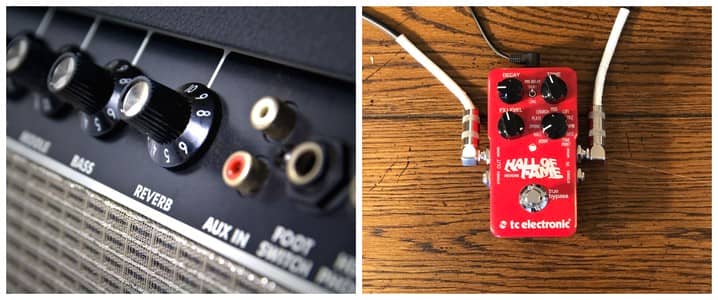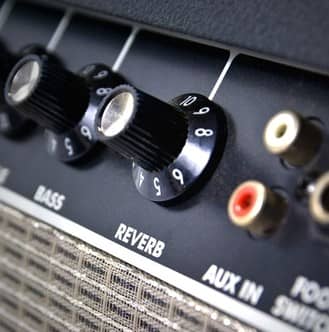Guitar players love the effect of reverb. This common effect adds ambiance, emotion, and the illusion of hearing guitar tones from small to vast open spaces.
However, many guitar players ask, is it better to use amplifier reverb or reverb from a pedal? I mean is one better than the other?
With these questions in mind, this post will take a look at both pedal reverb and amp reverb comparing sound, versatility, and more.

By the end of this post, you will understand both types of reverb sources and which option you prefer based on my comparison.
Before we dive deeper, let’s ask the question again…
Is Amp Reverb Better Than Reverb Pedals?
Amplifier reverb is considered more natural and organic especially from valve amplifiers but has limited flexibility. In contrast, most guitar effect pedals produce digital reverb but are considered more versatile for tone shaping and experimenting.
Reverb Pedals – Let’s Take a Look

In essence, most reverb pedals digitally replicate the sound of naturally reverberation. This is great for guitar players who want ultimate control of their time-based effects.
You can replicate from a small tilled room with lots of reflections to a gigantic cathedral with a dark atmosphere… all in one small pedal!
All reverb pedals come in different shapes, sizes and features depending on the cost. From mini “set it and forget it” pedals to large time based processing units with multiple bells and whistles.
Why Use a Reverb Pedal Over Amp Reverb?
So why reach for a pedal when most amps include reverb? Here are numerous reasons why…
1. Pedals are More Versatile
The amount of versatility you get from a pedal is much more so than from an amp. Pedals allow you to customize and tweak your time-based tone until you achieve the ultimate reverb for your sound.
Most reverb pedals even the super-budget ones (less than $40) offer a great selection of parameters to customize your guitar tone.
As with most amps, they have limited EQ options when it comes to the onboard reverb. Usually, an FX level and that’s about it, unfortunately.
Therefore pedals offer an excellent base to customize and achieve the perfect tone you desire. Either from super drenched surfer tones to subtle and dry tones to add a slither of ambiance.
2. Pedals Allow Experimentation
Reverb pedals allow you to experiment with various time effects from drenched ambient tones to subtle sounds that require a splash of reverb.
Furthermore, do you consider yourself a versatile player? With interests in many musical genres. Well, my friend, a reverb pedal will be perfect for you.
When your playing consists of a wide array of musical genres then you will want your effects to be versatile. A reverb pedal can give you a whole host of sounds and tones to keep up with many guitar tones.
3. Pedals Replace Bad Sounding Reverb
Don’t like the reverb that comes standard with your amp? No problem! Just use a reverb pedal instead. The problem with amp reverb is that besides the lack of versatility.
The main issue is that most amps (especially valve amps) only come with spring reverb. And guess what? if it sounds terrible then you are stuck with it and it can’t be changed.
This is why a pedal can be so useful for swapping out different aspects of your amp that you don’t like. For example, if your reverb from your valve, solid-state or, digital amp is bad, then simply use a good quality pedal.
Common Reverb Pedal Knobs
FX Type
Most pedals (depending on cost and features) will give you a selection of reverbs to choose from. The most common are:
- Spring
- Hall
- Chamber
- Plate
- Room
Each type of reverb includes their own individual sound depending on how the intensity of the effect. Most pedals will give you a solid selection of reverbs to choose from and customize further.
FX Level
FX Level is the amount of reverb you want the dry signal to have. The relation you see is usually dry/wet.
The drier the signal, the less noticeable the reverb will be (used to create a room sound or just some space for your guitar to sit in).
Conversely, the wetter the signal, the more present will the reverb be (used to create huge sounds or ambient atmospheres).
Decay
Decay refers to the amount of time it will take for the reverb’s sound to disappear.
Longer decays will indicate bigger rooms such as concert halls or auditoriums. Shorter decays indicate smaller rooms.
Pre-Delay Time
Pre-Delay Time is the interval between the dry signal and the wet signal. This gives you an indication of the space between your guitar and the reflecting surface it reacts upon.
One of the main uses of pre-delay is to create a bit of separation between the dry and wet signals to avoid the reverb from drowning out the original signal. This will give you a clearer sound.
Amplifier Reverb – Let’s Take a Look

The cool thing about most amps is that they produce reverb either analogue or digitaly depending on the amplifier.
Vintage amps from Fender such as the Fender Twin Reverb and Fender Vibroverb are famous for lush analogue reverbs created from spring box devices.
On the other hand, digital or solid-state amps include built in reverb similar to a pedal, where emulations are produced digitialy. So which to choose?
Fun Fact: In 1963, Fender included metallic springs on their Vibroverb model. By then, springs and plates were already used to create reverb in recordings but no one had incorporated a spring into an amp.
Why Use Amp Reverb Over Pedal Reverb?
To settle this debate, it depends on your amp and simply your personal tastes. First, we have to separate two types of amps
Tube/valve amps (usually vintage) include analog reverb as opposed to digital reverb used on modern solid-state and digital amps.
For your information, amps with analog reverb adopt metallic spring box devices that produce lush sounding reverb. Hence where ‘spring reverb’ gets its name from.
So why use your amps reverb instead of digital reverb?
1. Anolgue Reverb Sounds ‘Organic’
Many amp purists will argue that the vintage era reverb sounds better than its digital process counterpart. This does coincide with the analog vs digital gear debate!
With that said, In my opinion, I do like the organic sound of spring tank reverb compared to some cheap reverb pedals that do a sub-par job.
Spring reverb is quite difficult to capture and replicate digitally. This is one of the main reasons why I favor a valve/tube amp reverb over a pedal.
It is also important to mention that Fender became the absolute masters in spring reverb, which is why they are one of the most sought out amps, especially during the surfer rock decade.
However, there are some pretty good reverb pedals out there and I wouldn’t buy an amp based on how well the reverb performs. I favor reverb pedals due to their versatility.
Solid-State & Digital Amp Reverb
Solid-State and Digital Amp reverbs are very similar to pedal reverbs. They are replications of natural reverb and can have multiple types included.
The great thing is that the amp already includes the reverb and might be a good starting point to experiment with it.
The main downsides are that for the most part, their sound quality is a bit lower than the one of a specifically designated reverb pedal.
The parameters you can adjust will also be more limited than in a reverb pedal (depending on the pedal, of course)
Amp Reverb Pros & Cons
Are All Reverb Pedals Digital?
For the most part, yes. If we take a look into some of the best, most sought out reverb pedals we can see that they are mostly digital.
Pedals such as the Strymon BigSky, the Electro Harmonix Oceans 11, or the TC Electronic Hall of Fame 2 are all digital reverbs.
There are some really good analog reverb pedals and I would recommend taking a look into some of the spring-type reverbs out there since they are the hardest to properly replicate.
I would take a look at the Spaceman Orion or Danelectro’s Spring King Reverb for true spring reverbs.
Finally, I’d take a look into Keeley Caverns Delay-Reverb V2 for a multi-effect pedal with very interesting sounds.
These pedals are designed for someone to change their sound in a more aggressive way, rather than just adding depth to their already created sound.
Do I Need a Reverb Pedal If My Amp Has Reverb?
This is not a yes or no answer; it depends on your needs and where you stand in your development as a guitarist.
First and foremost, amp reverbs are good reverbs (especially spring-type reverbs on tube amps). They are simple to use and give you a balanced sound without having to do much.
However, as I’ve mentioned before, versatility and flexibility play a huge role in determining whether you want/need a reverb pedal or not.
Having multiple reverb types such as spring, plate, hall, room, chamber, etc. gives you a myriad of sonic choices that can heavily expand your style.
Having said this, it will also depend on how much you are willing to spend on a reverb pedal.
Many great, inexpensive reverb pedals can be a good enough upgrade for you. I would personally recommend getting a higher-end reverb pedal with lots of reverb types and parameters to adjust.
This will also enable you to better understand how reverb works and how to use it to your advantage.
My personal opinion is the following, reverb is an important tool and a reverb pedal is a great acquisition; however, a good overdrive/distortion pedal or a delay pedal can be as important.
I would recommend you take a look at where you think your sound is “weakest” and upgrade that aspect of your tone. Amp reverb can certainly do the job in the meantime.
Final Thoughts
Reverb is one of the most important and used effects in music. This holds even truer for guitar players who can create lush atmospheres with multiple types of reverbs. The way you add your reverb to your signal chain is all personal choice.
